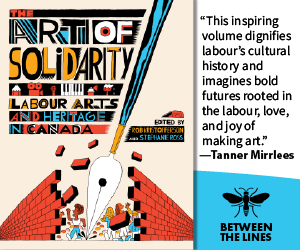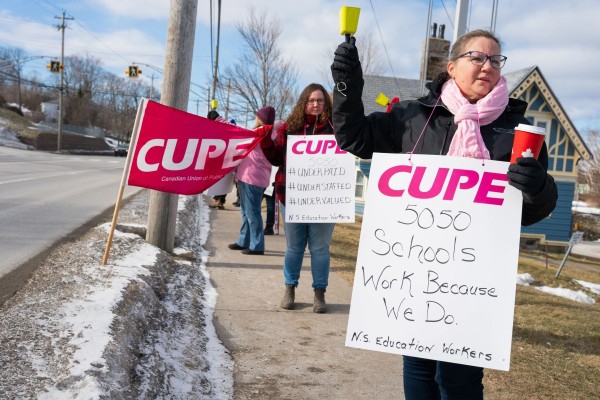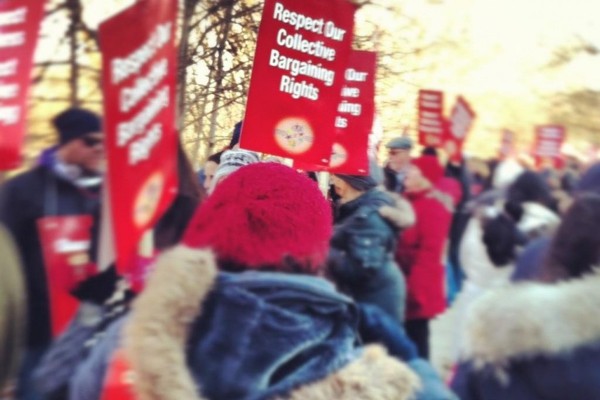The Road to Union Renewal: From Organizing the Unorganized to New Political Alternatives
In many of the advanced economies, unions are in serious trouble. Evidence of this is found in declining union memberships, the slowness with which new workers join unions and the political and social marginalization of unions and their central labour federations. This crisis for unions is in part the result of changing workplaces and labour markets compounded by the hostility of employers and governments to unions.
Unemployment, flexibilization, deregulation and cuts to the public sector have cut into the heart of union memberships. Global downward pressures on wages in manufacturing combined with the restructuring of many corporate operations into networks of small, flexible non-union workplaces increases workers’ vulnerability as well as their fears of job loss and employer retaliation for union involvement.
Employers and governments have seized upon the economic and political opportunities opened up by new competitive pressures and capital mobility to curb, if not eliminate, union influence. Although employers in the U.S. have gained the greatest notoriety for their union-avoidance tactics, similar tactics have been increasingly evident across all Anglo-American countries. Employers regularly oppose unions with a barrage of tactics including employing antiunion management consultants, threatening workers with workplace closure and job loss if they join a union, laying-off and firing workers for union organizing activity and, in some cases offering bribes to encourage anti-union sentiments. Anti-union hostility has been aided by the exponential growth in management literature on how to avoid unions and the emergence of American-based multinational law firms whose business worldwide is advising employers on the how-to’s of union-busting.
Employers have been helped in these endeavours by sympathetic governments. The elections of Margaret Thatcher in the UK in 1979 and Ronald Reagan in the U.S. in 1980 symbolized a regime change in industrial relations marked by active, employer hostility to unions, and rapid labour market deregulation and welfare state restructuring. The 2001 election in B.C. of the Campbell Liberal government is just the latest example in Canada of the election of anti-union governments. These governments not only bolster the anti-union tactics of private-sector employers, but encourage changes in the public sector. Public-sector employers have begun to mimic private-sector employers in their resistance to unions.
Yet, to argue that union decline has been the result solely of changes in the organization of capitalist economies and government and employer actions merely plays into the hands of those who insist that union fortunes can only be turned around with a return to better labour laws, and the election of social democratic parties. Analysts inside and outside the labour movement who perpetuate these ideas offer a fundamental misreading of history, namely that powerful labour movements developed in the wake of elected social democratic governments and improved labour laws, not the other way around. Moreover, such analysis puts too much faith in social democratic parties which over the last twenty years, in particular, have betrayed workers and unions interests in the name of economic competitiveness and temporary belt-tightening.
Rather, for union renewal to occur, unions need first to accept some responsibility for their own demise, and then engage in a systematic and radical course of internal change intent on rebuilding the strategic capacity and influence of labour movements. Coming out of a series of studies of union renewal in Canada and the Anglo-American democracies, I argue that there are four orders of change that need to take place within unions if they are to restore their political-economic influence. And, although several unions across a number of countries have embarked on some of these changes, sustained union renewal is rare and encounters considerable obstacles.
The first order of change involves organizing the unorganised. In Canada, as elsewhere, as early as the late 1950s, industrial and skilled trade unions became complacent about organizing unorganised workers. This was followed in the 1960s with a second wave of organizing, this time involving public sector workers. Thereafter, however, unions concentrated their resources and energies into consolidating their position vis-à-vis employers, rather than expanding their presence among the millions of unorganized workers. Consequently, the power of national labour movements in the postwar period rested on the representation of workers in select industries and workplaces, notably large industrial and resource based workplaces and the public sector.
White men tended to dominate union movements. Despite recent increases in women’s rates of unionization relative to men, unions have not kept pace with the changing racial, ethnic and cultural diversity of the workforce or shifts in employment. Yet, in Canada, as elsewhere, women, immigrants and racialized groups are more likely to join unions than other workers if they are given the opportunity. And this is no surprise. According to my survey of union organizers, women in workplaces being organized are more likely to experience a wage freeze than men, are more likely to suffer arbitrary management determination of wages and benefits and experience their work as belittled and undervalued by managers. If union survival depends upon reversing membership declines, then building membership among women and ethnically and racially diverse groups of workers is essential.
The Organizing Effort
Over the last decade, unions across Canada have followed in the footsteps of other labour movements in renewing their commitment to organizing. This has resulted in expanding resources invested into organizing and some spectacular organizing breakthroughs in non-traditional workplaces, such as the recent organization in B.C. of 6,000 casual and part-time extras in the film industry, the unionzsation of a handful of call centres, and the growing emphasis on organizing First Nations workers.
Yet, in spite of the hype in the labour movement over organizing the unorganised, the results to date have been disappointing. The CLC estimates that the number of workers organized into unions in Canada in a year peaked in 1998-99 at an estimated 85,619 and has since dropped to 57,230 in 2001-02. When asked, many workers report that they cannot find a union willing to organize and represent them. One woman who worked in a shelter in Toronto reported that she had called five unions trying to get organized. She never succeeded.
Yet, the strategic emphasis on organizing has ushered in a series of positive changes to unions including massive education campaigns intended to activate existing members, the emergence of a patchwork of cooperative relationships between unions and social movements and other community organizations and expanding the opportunities within unions for non-white, women, youth and new immigrants.
Change is slow, however. By the end of the 1990s, 87 and 79 per cent of organizers in Ontario and B.C. respectively were white and union leaders continue to be disproportionately male. Unions continue to be more likely to attempt organizing in traditional areas of union strength, such as small male-dominated worksites, yet insist that they have already ‘done’ the equality agenda for women and racialized groups.
Yet, according to many organizers, organizing the unorganised is easy. Real problems emerge as unions try to represent and bargain for new members who come from diverse communities and often work in scattered small workplaces. This brings us to the second and third orders of change, namely new forms of bargaining and renewed union democracy.
Bargaining for and representing workers in small workplaces is costly and often results in sub-optimal agreements due to a lack of bargaining leverage. If unions cannot ‘deliver the goods’ to new union members, union support goes down and the risk of de-certification goes up. Unions have therefore begun to experiment with ‘new’ approaches to bargaining. In response to union successes in organizing multiple small and dispersed bargaining units in the service sector, a number of unions have adapted coordinated master bargaining to the service sector. The USWA negotiated a single contract for Pinkerton security guards who are employed in worksites from one to one hundred workers. This master agreement reduces wage competition, offers workers job mobility from one site to another, increases union bargaining leverage and reduces the costs of bargaining. Master agreements have also been negotiated for Starbucks and KFC’s organized by the CAW in B.C. and community health care units in the B.C. interior organized by the BCGEU.
An inherent contradiction in current bargaining practices is union expectations of blind membership support during a bargaining process that is closed and secretive. Collective agreements are expected to grow like mushrooms in the dark. Where unions represent small numbers of workers and have limited bargaining leverage, the professionalization of and secrecy in bargaining undercuts them further by demobilizing, and hence disempowering workers. One example of a Winnipeg union local illustrates an alternative to this model of bargaining. A union local of 125 members faced employer demands for massive concessions. To mobilize against concessions, the local adopted an open-information strategy towards bargaining so that union members were informed daily about developments in bargaining. While this more open process increased membership pressure on union leaders at the bargaining table, it also mobilized the membership so that they mounted growing pressure on the employer through a variety of mass action and publicity campaigns.
Pressures for Greater Union Democracy
It is no coincidence that as unions have committed themselves to organizing the unorganised, pressures for greater union democracy have grown. Union democracy becomes both a means to represent and rebuild tactical unity out of a more diverse union membership as well as the foundation from which unions can mobilize active membership support. Newly organized workers, buoyed by union promises of a voice in their workplace and, oftentimes, bringing into unions distinct communities of interest and new concerns, expect unions to be democratic and open to new interests. At the same time, new hopes for union democracy are fanned amongst existing memberships as they believe their union’s organizing promises to represent and empower workers.
It is no surprise therefore that unions face re-mobilized memberships demanding real democracy. The case of the SEIU is illustrative. SEIU became the darling of the union media and an icon of organizing innovation with its Justice for Janitors campaign, which was built on the promise of union and workplace democracy. It is no surprise that SEIU members in Canada began to look for enhanced democracy in their own ranks. As this moved from an internal dispute to a struggle between the SEIU and the CAW, democracy became the driving rhetoric of struggle between these two unions. But few if any democratic changes resulted from this dispute, leaving many SEIU members jaded with both the SEIU and the CAW.
The foundering of democratic reforms is not new. We need only to look at the return of Hoffa-style leadership within the Teamsters, after initially encouraging victories of “Teamsters for a Democratic Union,” to see how quickly leadership can re-assert its control. Despite many compelling reasons why union democracy is an essential component of organizing the unorganised, union leaders, even of the hirtherto more democratic unions, begin to fear democratic impulses as challenges to their authority. It is therefore not surprising that many democratic reforms take place below the radar screen of national and international unions, at the local level.
Lacking a Coherent Political Project
Which brings us to the fourth order of change. Although much organizing is built on practices involving greater internal union democracy, membership activism and broader-based community alliances and coalitions, critics have argued that it lacks a coherent political project aimed at rebuilding the strength of the working class. Organizing addresses elements of the crisis of labour unionism rather than its source.
Which returns us to the age-old debate over political alternatives. To date, two different solutions to this dilemma have emerged. In Canada and the U.S, where unions are enterprise-based and lack concerted political representation through governing labour or social democratic parties, an argument has been made about the need to combine the ideas in the organizing model with a broader political agenda of democratization to encourage the growth of social movement unionism. For those countries where social democratic parties are more likely to win or already hold power, debate focuses on the virtues of partnership with ‘sympathetic’ governments versus the dangers of oppositional mobilization.
What is striking about both of these political options is their lack of any proposed real alternative. While the anti-capitalist language of socialism finds resonance in oppositional politics, the proposal of alternate means of organizing our societies has all but been silenced. Yet, unions and socialists alike should take more seriously the political alternatives offered in feminist socialist critiques of capitalism. With their focus on work-life balance, finding spaces outside of commodified social relations and their pursuit of radical agendas for equality, the building blocks for political alternatives exist. And feminists within the union movement know this. The question is whether unions are up to the task of embracing this alternative agenda, which would threaten existing power and privilege, not just in capitalist institutions but in unions as well.
Charlotte Yates is Director of Labour Studies at McMaster University in Hamilton.
This article appeared in the March/April 2004 issue of Canadian Dimension .










